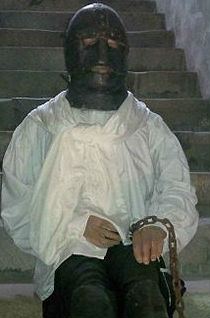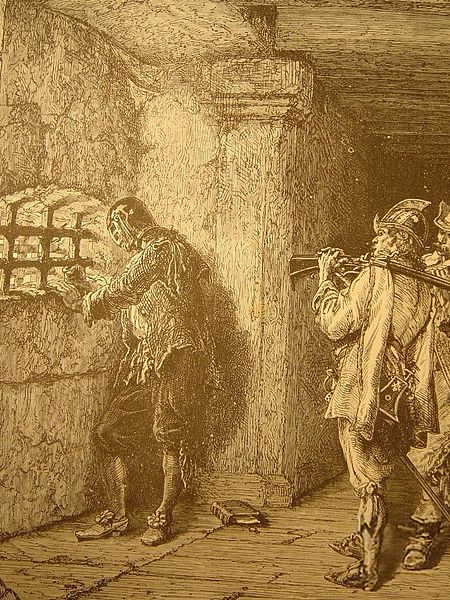The Legend Of The Man In The Iron Mask

“I believe that legends and myth are largely made of truth, and indeed present aspects of it that can only be perceived in this mode; and long ago certain truths and modes of this kind were discovered and must always reappear.”
- J.R.R. Tolkien
History has given us plenty of legends, conspiracies and controversies and we may never be able to fully separate fact from fiction. Stories about the Lost City of Atlantis as well as the Lost Roanoke Colony have kept folks enthralled for centuries along with some very famous people, like the Princes in the Tower. What happened to the Mayans? What is the Bermuda Triangle, really?
One of the most interesting of history's legends is that of the Man in the Iron Mask. Made popular by the serialized Three Musketeers novel by Alexandre Dumas, titled The Vicomte of Bragelonne: Ten Years Later and published from 1847-1850, The Mask in the Iron Mask was the third and last part of the series. In this tale, the Man in the Iron Mask is the identical twin brother of the French King Louis XIV, doomed to rot in the Bastille in a wrought iron contraption that kept his face covered so he could not be identified.
This tale has been told many times, and has even been made into major motion pictures. It is also, at times, hotly debated, because the legend of the Man in the Iron Mask just might be true.

Just the Facts: Bénigne d'Auvergne de Saint-Mars, Eustache Dauger and Marchialy
The Man in the Iron Mask all started with the records of a jailer named Lieutenant Etienne du Junca. He was employed at a prison called The Bastille, in Paris, France. Modern folks know of The Bastille because of the "Storming of the Bastille" during the French Revolution on July 14, 1789. By that time, of course, our Man in the Iron Mask was long gone.
However, on September 18, 1698, a new warden came to the Bastille. His name was Bénigne d'Auvergne de Saint-Mars and, with him, came at least one prisoner that he moved from his last assignment at the Fortress of Pignerol, in what is now Pinerolo, France. This wasn't an ordinary prisoner, however, and Du Junca made a journal entry describing how Saint-Mars "brought with him, in a litter, a longtime prisoner, whom he had in custody in Pignerol, and whom he kept always masked, and whose name has not been given to me, nor recorded."
Further reading into Du Junca's journals indicate that the masked man was a model prisoner and was treated fairly and even allowed to attend Mass - with a mask of black velvet covering his face. Du Junca's journal entry for November 19, 1703 described the funeral for this masked "unknown prisoner, who has worn a black velvet mask since his arrival here in 1698." Saint-Mars registered the death of this prisoner under the name Marchialy. We will likely never know if this was the prisoner's true name, but historians and mystery lovers alike seem to agree that it was not.
This story may have begun a little earlier, in 1669. The Marquis de Louvois, a minister of King Louis XIV of France, sent Saint-Mars a letter detailing a new prisoner that was to be sent to him at Pignerol along with some pretty strange requirements for the keeping of the prisoner. Louvois ordered that a cell be built or modified with multiple doors to make eavesdropping on this special prisoner impossible. The name given for this prisoner was Eustache Dauger, or D'auger.
What was even more interesting about this letter was the fact that all of the note was written in the same handwriting, with the exception of the name of the prisoner. This indicates to some that the letter was written by a scribe or clerk, and that Louvois himself wrote the prisoner's name so that no one would be aware of it save for Saint-Mars and himself.

The Man In The Iron Mask: Blurring the Line Between Truth and Fiction
It is because of the philosopher Voltaire that we identify this prisoner as having worn a mask made of metal instead of the black velvet that official documents suggest. In his work Questions sur l'Encyclopédie in 1771, he referred to this famous prisoner as wearing a metal mask bearing a "movable, hinged lower jaw held in place by springs that made it possible to eat wearing it." According to Voltaire, the mask had been riveted on and was not removable.
With the tales of the Three Musketeers came a renewed interest in the Man in the Iron Mask. Alexandre Dumas took the already existing legends and added his own liberal artistic license. In his novel, the prisoner is the identical twin brother of Louis XIV, imprisoned to quash any possible uprising or attempts to take the crown of France.
There are many problems with this theory that are sometimes accepted by some as fact. Saint-Mars did ask Louis XIV for permission for Dauger to act as a servant for another, very wealthy prisoner at Pignerol - a man by the name of Nicolas Fouquet the Marquis of Belle-Île - and the King was very specific that Dauger was only to act as a valet for Fouquet if his original servant were ill or otherwise unavailable. If Dauger had been royal, as legends suggest, he would not likely have been allowed out of his cell or would he be able to mix with other prisoners. Also, the possibility of someone of royal birth acting as a servant to anyone is highly unlikely.
There have been two historic hearsay references to the masked man having been Italian. Madame du Pompadour, the mistress of King Louis XV, is said to have heard from her lover that the masked prisoner was the "minister of an Italian prince." Also, Louis XVI is said to have told his wife, Marie Antoinette, that the prisoner was a political dissident from the Italian town of Mantua.
Either could be true, as there were Italian prisoners under the care of Saint-Mars for a relatively long period of time, beginning with his position at Pignerol which was near the Italian city of Turin. The mystery only thickens when historians poured over all of the available records from Stain-Mars' time at Pignerol. One of the prisoners he tended there was a man named Antonio Ercole Matthioli, which could easily have been misspelled as Marchialy.
There have been other theories as to the identity of the Man in the Iron Mask over the centuries, however nearly all of them have been discounted as speculation, if not total fiction. Here are just a few of them:
- The prisoner was the illegitimate child of either Charles I of England, Oliver Cromwell or the Queen Mother, Anne of Austria. It has been suggested that the Man in the Iron Mask was actually a woman, again possibly the illegitimate child of Anne of Austria.
- It has been said that the prisoner could have been an older brother of Louis XIV. That theory was exaggerated even further by adding that this older royal's true last name was Bonaparte, which could have made Napoleon of noble birth - had it been true.
- One theory had the Main in the Iron Mask as a black man who had impregnated Anne of Austria. It was said the man was masked because his color would have identified him.
- Molière, a playwright, who actually died in 1673 was said to be this prisoner. He was supposed to have faked his death or had it fabricated when he was arrested.
- One theory suggests that he was the illegitimate child of Louis XIV, of which there were allegedly many, although he later legitimized them and made sure they were educated (and some of their mothers were given titles).
As you can see, there are many different twists to this tale which has grown exponentially over the centuries. The truth is that we may never know the true identity of the Man in the Iron Mask and that truth may not be nearly as exciting as the myths and legends that surround one of history's most famous mysteries.





